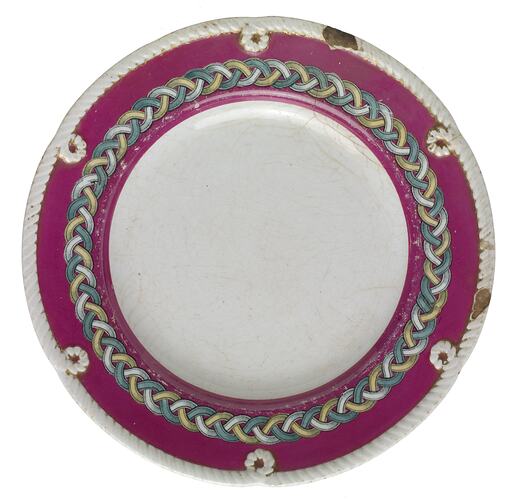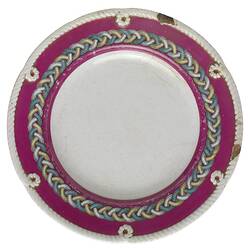Background
Samuel Walker McGowan was the man responsible for the introduction of the electric telegraph to Victoria and Australia. He set up the first telegraph line between Melbourne and Williamstown, and began operations in March 1854. McGowan was appointed Superintendent of the Electric Telegraph in Victoria. McGowan was a real enthusiast for telegraphy, to the extent that he had a 'telegraphic' dinner service specially made for him in England. An article by Geoffrey Tebbutt in the Melbourne Herald in 1954, on the occasion of the centenary of the beginning of the telegraph in Victoria, describes the dinner service as being '. red and white, with elaborate Morse and cable motifs and a compass in the centre of each plate. Only two sets were made.' Tebbutt also tells how McGowan and his wife Annie used to tap messages to each other in Morse code across the dinner table when they didn't want their children to know what was being said.
How Museum Victoria got the plate
The Herald article included interviews with Mrs R. W. Craig, a grand-daughter of McGowan, and with Mr Frank Walker, whose late wife was a daughter of McGowan. Both Mrs Craig and Mr Walker still had some pieces of the McGowan dinner service, and Mrs Craig was photographed with two plates and what appears to be a soup tureen. A check of wills showed that Mrs Craig had left her pieces of the dinner service to her cousin Eleanor in Queensland. One of these Queensland plates was located by Ms Patricia Rowland among the possessions of her mother, Mrs Grace Rowland, who was married to Edward McGowan Rowland, son of Eleanor and great-grandson of Samuel Walker McGowan. Mrs Rowland graciously agreed to donate the plate to the Museum of Victoria, with the dedication: 'Donated by Grace Rowland In loving memory of her husband Edward McGowan Rowland.
Description of the plate
The plate donated by Mrs Rowland has a diameter of just under 24 centimetres, and weighs (very) roughly 200 grams. The raised rim of the plate is about 4 cm wide, and moulded into the edge of the rim is a rope or cable pattern about 1 cm wide. Six loops about 1 cm in diameter are moulded into the rope at equal spacings around the plate circumference. The basic plate colour is white. The moulded rope round the edge is white, with remaining traces of gold picking out the edges of the turns of the rope strands. The applied design consists of a band of deep pink colour, about 3.5 cm wide running round the rim, just inside the white moulded rope. The pink band extends over the inner edge of the rim by about 8 mm down into the centre of the plate. Superimposed on the pink band and running right round the plate is a cable pattern comprised of three strands coloured respectively green, white and yellow. Each strand is about 4 mm wide, and the overall cable pattern is about 15 mm wide. The central part of the plate is plain white. Tebbutt's article mentions a compass in the centre of each plate, but at first glance the donated plate does not have such a compass. However, when viewed under glancing light it is possible to discern the faint outline of a pattern in the centre of the plate. Not much detail can be distinguished, but there seems to be a circular pattern, about 2 cm in diameter. Six projections, about 1 cm long extend outward from the central circle at equal spacings around its circumference. Each of these projections is shaped roughly like a fleur-de-lys. In each of the spaces between these projections is a smaller projection, about 3 mm long. The overall pattern might be described as a compass, although a compass would normally have four or eight points rather than six. There is no sign of the Morse code motifs mentioned in Tebbutt's article. There is no specific manufacturer's name or emblem on the plate. In the centre of the underside of the plate is an impressed diamond shaped emblem which is a Design Registration Mark, of the type used on British pottery in the years 1842 to 1868. The details are rather indistinct but seem to indicate that the design was registered in April 1858. The registration may apply to the basic shape of the plate, and not necessarily to the applied design. In addition, the figure '2' is painted immediately above '4621' on the underside of the plate.
A partially detached gummed paper label in the centre of the underside of the plate carries the signature 'E. McGowan', the figure '21' above the signature, and the figure '(4)' below the signature.
More Information
-
Keywords
-
Authors
-
Article types


